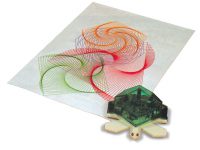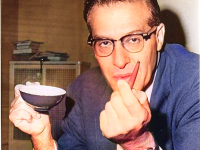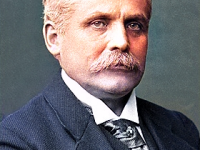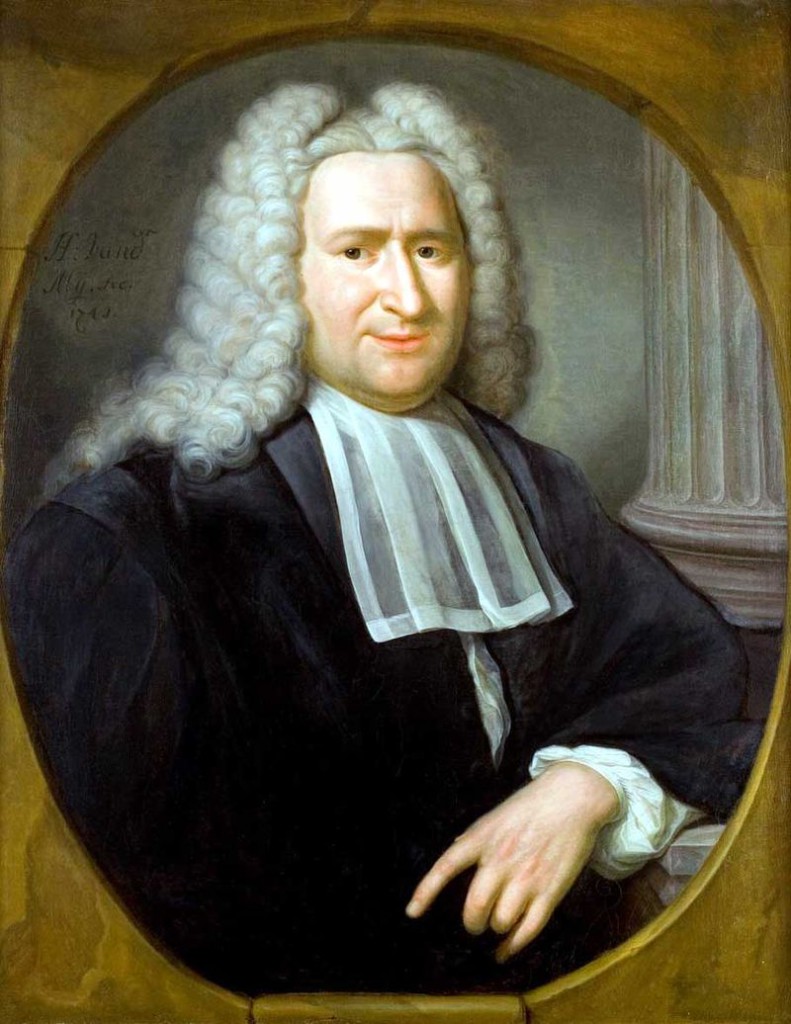
Pieter van Musschenbroek (1692-1761)
On March 14, 1692, Dutch scientist Pieter van Musschenbroek was born. Musschenbroek is credited with the invention of the first capacitor in 1746: the Leyden jar. He performed pioneering work on the buckling of compressed struts. Musschenbroek was also one of the first scientists (1729) to provide detailed descriptions of testing machines for tension, compression, and flexure testing.
Youth and Education
Pieter van Musschenbroek was born in Leiden, Holland, Dutch Republic. His father Johannes van Musschenbroek originated from a Flemish family who lived in the city of Leiden since circa 1600. As an instrument maker, Johannes van Musschenbroek made scientific instruments such as air pumps, microscopes, and telescopes. Pieter van Musschenbroek attended Latin school until 1708, where he studied Greek, Latin, French, English, High German, Italian, and Spanish. He studied medicine at Leiden University and received his doctorate in 1715. He also attended lectures by John Theophilus Desaguliers and Isaac Newton in London.[8] He finished his study in philosophy in 1719.
Elementa Physica
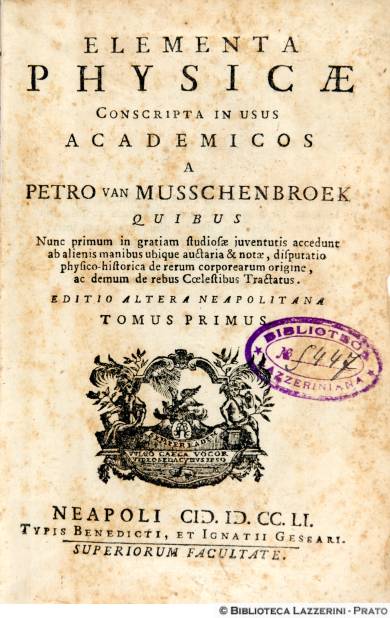
Pieter van Musschenbroek, Elementa Physicae conscripta in usus academicos, Neapoli 1751
In the same year, he became professor of mathematics and philosophy at the University of Duisburg. In 1721, he also became professor of medicine. In 1723, he left his posts in Duisburg and became professor at the University of Utrecht. He provided the first approach to scientific study of electrical charge and its properties. In 1729, Musschenbroek used the word “physics” which had never been used before. In 1732 he also became professor in astrology. Musschenbroek’s Elementa Physica (1726) played an important part in the transmission of Isaac Newton’s ideas in physics to Europe. In November 1734 he was elected a Fellow of the Royal Society and member of the French Academy of Sciences in the same year. Musschenbroek belonged to the tradition of Dutch thinkers who popularized the ontological argument of God’s design.
“I’ve found out so much about electricity that I’ve reached the point where I understand nothing and can explain nothing.”
— Pieter van Musschenbroek, in a Letter to Réamur (20 Jan 1746), in AS. Proc. verb., LXV (1746), 6. Cited in J. L. Heilbron, Electricity in the 17th and 18th Centuries: a Study of Early Modern Physics (1979), 314.
The Discovery of the Capacitor
Already during his studies at Leiden University Van Musschenbroek became interested in electrostatics. In their attempts of November 1745 to produce sparks and flashes by friction that Gilbert, von Guericke,[4] Hauksbee, and Dufay had previously done experimentally, professors Musschenbroek and Swiss-Dutch natural philosopher Jean Allamand of the University of Leyden and Musschenbroek’s student Andreas Cunaeus experimented with a glass jar connected to an friction electrical machine. Musschenbroek had suspected that a nonconductor vessel (glass) would be helpful to them so on this occasion in January 1746 he partly filled a bottle with water. He knew that water was a conductor of electricity. Musschenbroek, while holding the jar with his right hand and a piece of wire with his left hand had one of his assistants connect it to the friction electrical machine, and then turn its glass globe, but nothing occurred until Cuneus placed one end of the wire into the water while Musschenbroek, grounded, was still holding the wire. A violent shock was felt which Musschenbroek described. The jar device had accumulated the electricity produced by the static machine and then all at once it discharged to Musschenbroek.[2] After having experienced the shock himself he writes, in a letter to his French colleague René Réaumur, that the whole kingdom of France could not compel him to repeat the experience.[3,5]
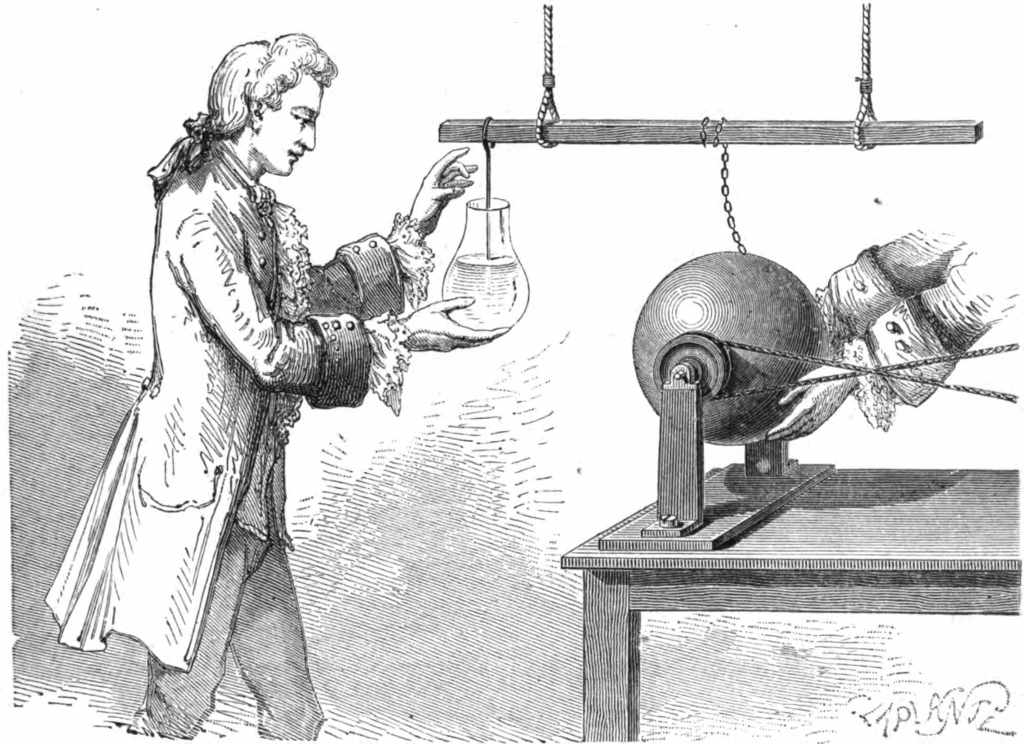
Artist’s conception of the discovery of the Leyden jar, in Augustin Privat Deschanel (1876) Elementary Treatise on Natural Philosophy, Part 3: Electricity and Magnetism, D. Appleton and Co., New York, translated and edited by J. D. Everett, p. 570, fig. 382
The Leyden Jar
The apparatus was a glass jar filled with water into which a brass rod had been placed; and the stored energy could be released only by completing an external circuit between the brass rod and another conductor, originally a hand, placed in contact with the outside of the jar. Van Musschenbroek had communicated this discovery to Réaumur in January 1746, and it was Abbé Jean Antoine Nollet, the translator of Musschenbroek’s letter from Latin and a great popularizer of electrical phenomena esp. Musschenbroek’s outlet in France for the sale of his company’s ‘cabinet’ devices, who named the invention the ‘Leyden jar‘. Nollet lost no time in contriving even more spectacular demonstrations. They culminated in one involving 700 monks joined in a circle to a Leiden jar.[3]
Further Improvements
News of the Leiden experiments reached London equally quickly, where in the same year 1746 they caught the attention of the versatile William Watson, physicist, physician, and botanist. He, too, set about repeating the basic experiments of Van Musschenbroek, improving the Leiden jar by coating its inside and outside with metal foil. In so doing, he observed a pattern of electrical discharge – namely, that a participant tended to feel the shock ‘in both his arms and across his breast‘. This suggested that a single ‘electrical aether’ or fluid is transferred, but never created or destroyed, from one body to another only when one has a surplus and the other a deficit of electrical aether.[3]
Discovered Again
Soon afterwards, it transpired that a German scientist, Ewald von Kleist,[6] had independently constructed a similar device in late 1745, shortly before Musschenbroek. Daniel Gralath was the first to connect several jars in parallel to increase the total possible stored charge. The term “battery” was coined by Benjamin Franklin for these combinations, who likened it to a battery of cannon (cannons grouped in a common place).[7]
In 1754, Van Musschenbroek became an honorary professor at the Imperial Academy of Science in Saint Petersburg. He was also elected a foreign member of the Royal Swedish Academy of Sciences in 1747. Van Musschenbroek died on 19 September 1761 in Leiden.
Walter Lewin, Lec 08: Polarization and Dielectrics | 8.02 Electricity and Magnetism, Spring 2002, [10]
References and Further Reading:
- [1] The Leyden Jar and the Age of Electricity, yovisto Blog, October 11, 2012.
- [2] Pieter (Petrus) van Musschenbroek (1692-1761), at Corrosion Doctors
- [3] The Leiden Jar, at Instituut-Lorentz, Leiden University, acc. to Per F. Dahl, Flash of the Cathode Rays (Institute of Physics, Bristol, 1997).
- [4] Otto von Guericke and the Horror of Vacuum, SciHi Blog, November 30, 2013.
- [5] Réaumur and the Réaumur Temperature Scale, SciHi Blog, October 17, 2015.
- [6] The Leyden Jar and the Age of Electricity, SciHi Blog, October 11, 2012.
- [7] Benjamin Franklin and the Lightning Rod, SciHi Blog, June 15, 2012.
- [8] Standing on the Shoulders of Giants – Sir Isaac Newton, SciHi Blog
- [9] Pieter van Musschenbroek at Wikidata
- [10] Walter Lewin, Lec 08: Polarization and Dielectrics | 8.02 Electricity and Magnetism, Spring 2002, For the Allure of Physics @ youtube
- [11] Jan Jozef Maria Hubert Verzijl: Musschenbroek (Petrus van). In: Petrus Johannes Blok, Philipp Christiaan Molhuysen (eds.): Nieuw Nederlandsch Biografisch Woordenboek. Teil 10. N. Israel, Amsterdam 1974, Sp. 659–660
- [12] List of Ph.D. students of Pieter van Musschenbroek
- [13] Timeline of Dutch Inventors, via DBpedia and Wikidata


